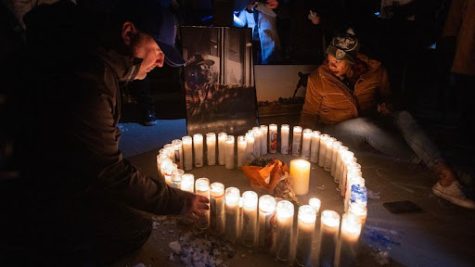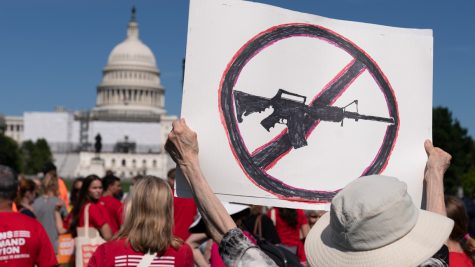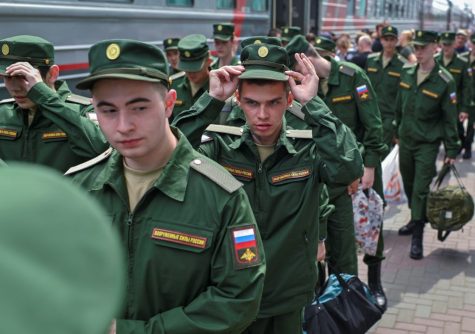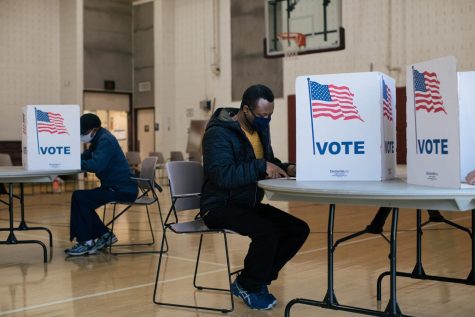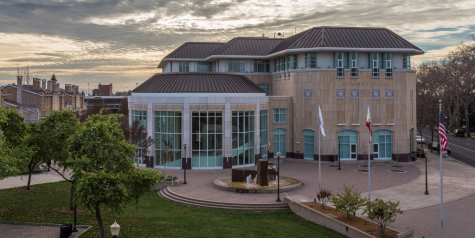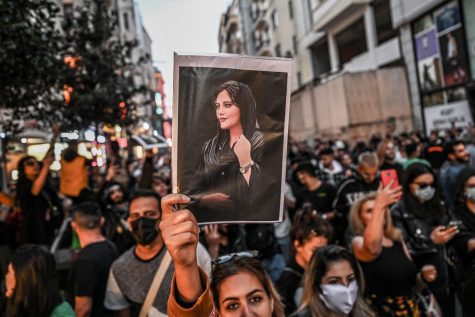San Leandro Mayor Addresses Infrastructure and Budget in State of the City
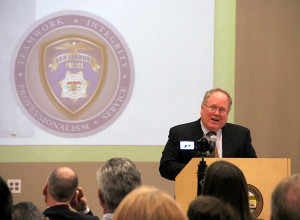 San Leandro Mayor Stephen Cassidy presented his State of the City address last Thursday, portraying a positive vision for the investment of businesses in the area, while addressing larger concerns about infrastructure and the budget.
San Leandro Mayor Stephen Cassidy presented his State of the City address last Thursday, portraying a positive vision for the investment of businesses in the area, while addressing larger concerns about infrastructure and the budget.
Cassidy portrayed the city as being modern and friendly to new tech businesses, thanks to the implementation of the Lit San Leandro; a program that brings high-speed fiber optic internet access to the city.
The city estimates it is 2,000 times faster than average internet connections and can download files at 10 gigabytes per second, whereas regular internet networks in California can download at speeds of 2.5 megabits per second, according to a Los Angeles Times article.
“Investment and development follow infrastructure,” said Cassidy. “In the 18th century it was seaports. In the 19th century it was railroads. In the 20th century it was highways and airplanes. Today it is ultra-high speed broadband connectivity. If you build it, they will come, and San Leandro has it all.”
Before the mayor took the podium, Byron Benton, training director for the Alameda County Electrical JATC, talked excitedly about the creation of a new “Zero Net Energy” building in San Leandro, due to open May 30.
“Zero net energy means we produce as much energy on site at the end of one year, as we use,” said Benton.
Benton said the turnout for the opening is expected to range between 500 to 1,000 people, with Governor Jerry Brown among those expected to attend the unveiling. He added, it is the first existing commercial building that will be retrofitted to become wholly sustainable.
The “Zero Net Energy” building will be used by the International Brotherhood of Electrical Workers Local 595 Union and the Northern California Chapter of the National Electrical Contractors Association, Cassidy said. The construction of the building precedes the 2030 requirement for all new buildings within the state to put out zero energy emissions.
Last September the city received $2.1 million in grant aid from the federal Economic Development Administration, which allows for construction of 7.5 miles of new conduit for the Lit San Leandro system. This brings the total coverage of fiber optic internet access in the city to roughly over 18 miles, covering most of the cities 13.34 square miles.
Cassidy said that FCC chairman Julius Genachowski stated San Leandro “joins a small but important number of communities that understand the critical importance of high speed broadband to our economy.” He added the city, “could be a model for the country.”
The mayor credited the city’s progress to the organizational work of City Manager Chris Zapata.
“Much of the success for our city tonight in my speech can be attributed to his leadership and that of our Assistant City Manager Lianne Marshall and our department managers and directors,” he said.
The schools of San Leandro have been doing well despite budget cuts by the city, said Cassidy. The school district, along with Supervisor Wilma Chan, acquired a federal grant to build a health clinic, allowing the city to receive interest payments from the school district at a rate greater than what they are receiving on reserve funds, said Cassidy. However, he said, the rate was still “fair.”
The $1.2 million grant will allow for the purchase of a building on East 14th Street near San Leandro High School to be used as counseling center for students, said Cassidy.
The mayor stated that in addition to this, the library last year was able to provide patrons with electronic and downloadable books online.
While there has been greater investment in the city and businesses have actually begun moving into San Leandro, the Mayor said, the city still faces many challenges, namely the increase of crime throughout the state in recent years.
Since January, burglaries in the city have been on the rise, according to Cassidy. Quoting San Jose Mayor Chuck Reed, Cassidy stated that the cause for this “may be tied to the state’s prison realignment plan, which allowed qualified inmates to be released early.”
To combat the increase in crime, Police Chief Sandra Spagnoli has increased community outreach and proactive enforcement. The police department has set up informational booths outside of commercial centers to build a stronger relationship between the community and the police.
“This trust is vital, as keeping San Leandro safe is everyone’s responsibility. We all need to be the eyes and ears of our police,” said Cassidy. “By reporting suspicious activity as it occurs, we enable our police to catch criminals and create the reputation among the criminal element in the Bay Area that San Leandro is a city to avoid.”
The police department switched from a more traditional approach in policing, from assigning officers to specific beats or neighborhoods, to focusing efforts on more problematic areas.
“Specific areas of San Leandro receive greater police resources based upon statistical models that analyze and predict likely criminal activity, down to the day of the week, and the day and location based upon past crimes,” said Cassidy.
The physical condition of the streets of San Leandro is another concern for the city. Currently, $2 million a year is spent to maintain the roads in the city, however, that only covers a third of what is required to maintain roads in their current condition.
“Our streets are at risk of accelerated deterioration if action is not undertaken,” Cassidy grimly stated.
He lamented the failure of Measure B1 on the ballot in November, which would have provided funds to repair the roads. The reason why the city can’t raise enough money on its own is due to repeated budget shortfalls, said Cassidy.
The past two fiscal years the city has balanced its budget. In 2011, the city even had a surplus, stated Cassidy. However, a transfer of $600,000 to the city’s reserve fund put the city into deficit spending for the fiscal year of 2012.
The city’s decision to refinance some of the debts it owes to different agencies allowed it some savings, said Cassidy, but it has largely been strapped for cash due to rising healthcare benefit costs and pensions.
For this reason, Cassidy candidly admitted, city employees have not seen a raise in several years.
Due to these costs, the city will see a $2 million deficit for the fiscal year 2014, and $4 million in 2015. He said the city is committed to a balanced budget for the next two years, but “to do so will require continued sacrifices by our employee groups.”
Expenditures are also rising, due to the end of a federal grant funding five officer positions; none of the hired officers will be laid off, he said.
“The expense must now be shouldered by our general fund, costing us $450,000 next fiscal year, and 900k in the following fiscal year,” said Cassidy.
Trouble with the Alameda County Fire Department in the past year has also lead to a shift in the city’s policy toward firefighters. The city employs 63 firefighters from the county, and will now have to pay $18.5 million in healthcare and pensions to retired firefighters; the city plans to pay $1 million of that cost annually.
David Rocha, deputy fire chief of the Alameda County Fire Department, refuted part of the mayor’s speech.
“There is an unfunded liability, an accrued liability, that is there. The statement that the fire department has not disclosed that…the city has made a policy level choice over the years dating back to when we first did a report on it to determine what they were going to do about that,” said Rocha. “The numbers have been disclosed, it’s been a budget choice for them in past years to do something.”
When asked by The Pioneer if this would affect individual firefighters Rocha stated, “it could.”







